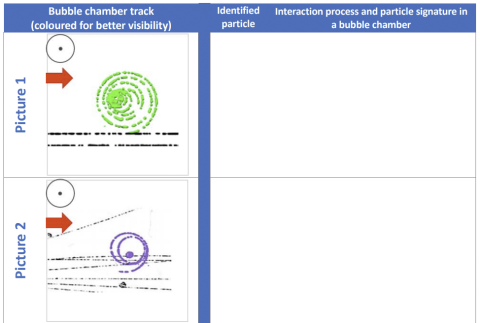Bubble Chamber Pictures for the Classroom

Dive into the fascinating world of bubble chambers and analyse tracks of high-energy particles in your classroom.
Description
Dive into the fascinating world of bubble chambers and explore how particle physicists used them to study high-energy particles. Using authentic CERN photographs, students can analyse the curved tracks left behind by charged particles and apply fundamental physics concepts to identify them.
This resource includes guided activities that help students interpret particle motion, charge and momentum through visual data. It’s a powerful way to introduce topics like magnetic fields, conservation of momentum and particle transformations using real-world examples. You can learn more about the history and physics of bubble chambers here.
Material List
Below you can find the key materials you need to run the Bubble Chamber activities in the classroom. Similar materials were used to observe, measure and interpret particle tracks from real CERN bubble chamber photographs.
- Student worksheet describing these activities with solutions and additional information for teachers here: docx, pdf (version 12-03-2018)
- Scissors
- Glue
- Ruler
- Pen or pencil
- Pocket calculator
Instructions
The following steps guide students how to use the worksheet and photographs to explore charged particle motion and identification.
- Download and print the student worksheet and example photographs.
- Read the background section to understand the principles of bubble chamber detection.
- Use a ruler to measure the curvature of particle tracks in the photographs.
- Apply the right-hand rule to determine the charge of particles based on their curvature in a magnetic field.
- Use the track radius to calculate the momentum of selected particles.
- Compare track shapes and thicknesses to identify particle types (e.g. electrons, positrons, protons).
- Follow the worksheet tasks to explore particle decays, including pion transformation events.
- Discuss observations and results in small groups or with the class.
Ideas for educators
- Start with a discussion about how scientists visualise things they cannot see by interacting with the invisible and studying the interaction.
- Use the bubble chamber photographs to introduce the concepts of charge, momentum and magnetic fields.
- Challenge students to apply the right-hand rule to determine charge signs from curvature.
- Combine this activity with a cloud chamber demonstration for historical comparison.
- Encourage students to explore more advanced analysis exercises using Peter Watkins’s website.
- Watch this lecture by Don Glaser, who won the 1960 Nobel Prize for Physics for his invention of the bubble chamber at Berkeley Lab. He discusses how, inspired by bubbles in a glass of beer, he invented the bubble chamber and detected cosmic-ray muons.
Related resources
- The images used the activity we propose were produced by the 2 m-long bubble chamber at CERN in 1972. The bubble chamber was exposed to a beam of protons from CERN’s proton synchrotron PS with a momentum of 24 GeV/c.
- Explore how a different detector, the Cloud chamber, visualises charged particles using supersaturated alcohol vapour.
- Find out about recent dark matter detection experiments using bubble chambers from the PICO experiment website and the Fermilab website.